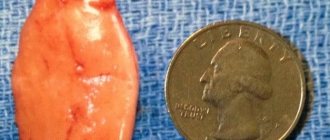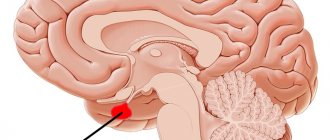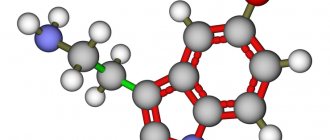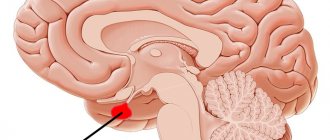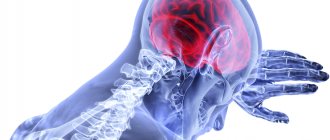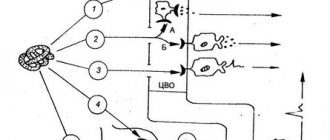The pituitary gland is an important regulatory center that coordinates the interaction of the endocrine and nervous systems of the human body. This organ is called the "master gland" because its hormones control the activity of other endocrine glands, including the adrenal glands, the thyroid gland, and the reproductive glands (ovaries and testes), and in some cases have direct regulatory effects in major tissues. Disruption of the pituitary gland affects the functioning of all organs and systems of the body and becomes the cause of many pathologies or deviations in human development.
COST OF SOME ENDOCRINOLOGIST SERVICES IN OUR CLINIC IN ST. PETERSBURG
| Price of a comprehensive examination for hormones (12 indicators) | from 6490 rub. |
| Endocrinologist appointment | 1000 rub. |
| Ultrasound of the thyroid gland | 1000 rub. |
| Call free: 8-800-707-1560 *The clinic is licensed to provide these services | |
What is the pituitary gland
The content of the article
The pituitary gland is a tiny endocrine organ located at the base of the brain, in a bone formation, the so-called “sella turcica”. It is oval in shape and about the size of a pea - about 10 mm in length and 12 mm in width. Normally, in a healthy person, the weight of the pituitary gland is only 0.5-0.9 g. In women, it is more developed due to the synthesis of the hormone prolactin, which is responsible for the manifestation of the maternal instinct. The amazing ability of the pituitary gland is that it increases during pregnancy, and after childbirth the previous size is not restored.
The pituitary gland is largely controlled by the hypothalamus, which lies above and slightly behind the gland. These two structures are connected by the pituitary, or funnel-shaped, stalk. The hypothalamus is capable of sending stimulating or inhibitory (suppressive) hormones to the pituitary gland, thereby regulating its effect on other endocrine glands and the body as a whole.
The “conductor of the endocrine orchestra” consists of the anterior lobe, intermediate zone and posterior lobe. The anterior lobe is the largest (occupies 80%) and produces and releases large amounts of hormones. The posterior lobe does not produce hormones as such - this is done by nerve cells in the hypothalamus - but it releases them into the circulation. The intermediate zone produces and secretes melanocyte-stimulating hormone.
The pituitary gland is involved in several body functions, including:
- regulation of the activity of other organs of the endocrine system (adrenal glands, thyroid and gonads);
- control of growth and development of organs and tissues;
- control over the functioning of internal organs - kidneys, mammary glands, uterus in women.
Location of the gland
The organ is localized in the lower part of the brain and belongs to its processes. The pituitary gland is located in the center of the skull, above it is the hypothalamus. The appendage is located in the recess of the sphenoid bone, in most cases it completely fills it, sometimes only half of the volume. With hypertrophic changes, the organ may extend beyond the bone pocket.
The size of the iron is small:
- in height – 3-8 mm;
- width – 10-16 mm;
- weight – does not exceed 1 g.
On the posterior, inferior and anterior sides, the pituitary gland is protected by bone structures and is covered on top by a diaphragm with an opening. A leg passes through it, connecting the gland to the hypothalamus.
Hormones of the anterior pituitary gland
This part of the pituitary gland is called the adenohypophysis. Its activity is coordinated by the hypothalamus. The anterior lobe of the pituitary gland regulates the activity of the adrenal glands, liver, thyroid and gonads, bone and muscle tissue. Each hormone of the adenohypophysis plays a vital role in endocrine function:
| Hormone | Target organs | Main function |
| Growth hormone (somatotropin) | Musculoskeletal tissue | Promotes body tissue growth |
| Prolactin | Mammary gland | Promotes milk production |
| Thyroid-stimulating hormone | Thyroid | Stimulates the production of thyroid hormones (triiodothyronine and thyroxine), which have an important effect on metabolic processes |
| Adrenocorticotropic hormone | Adrenal cortex | Stimulates the production of cortisol hormones from the adrenal cortex, which have anti-inflammatory and immunosuppressive effects and participates in the metabolic process |
| Follicle stimulating hormone | Ovaries and testes (testes) | Stimulates the maturation of follicles in the ovary and spermatogenesis in the testicles, the development of secondary sexual characteristics |
| Luteinizing hormone | Ovaries and testes (testes) | Ovulation, testosterone production, development of secondary sexual characteristics. |
Let us consider in more detail each hormone of the anterior pituitary gland.
Structural and physiological features
The organ has an oval shape; its structure has two uneven lobes: posterior and anterior. There is also a middle, intercalary part, in which beta-melanocyte-stimulating hormone is produced.
Experts distinguish two main lobes of the organ:
- Adenohypophysis
It is the anterior lobe of the inferior medullary appendage and includes three-quarters of the total volume of the pituitary gland. The structure of the organ contains glandular cells responsible for the production of tropic hormonal substances. Hormones are designed to control the activity of endocrine glands located in the periphery.
The anterior lobe is additionally equipped with zero cells that do not participate in the production of hormonal substances. Research has not been able to fully determine their function.
- Neurohypophysis
It is the posterior part of the pituitary gland and is not intended to produce hormones. Its functionality is based on the accumulation of neuropeptides synthesized by the hypothalamus. Vasopressin and oxytocin are activated in the organ; after completion of the process, the elements are redirected into the bloodstream.
Growth hormone (somatotropin)
The endocrine system regulates human body growth, protein synthesis, and cell replication. The main hormone involved in this process is growth hormone, also called somatotropin, a protein hormone produced and secreted by the anterior pituitary gland. Its primary function is anabolic: it directly accelerates the rate of protein synthesis in skeletal muscle and bone. Insulin-like growth factor is activated by growth hormone and indirectly supports the formation of new proteins in muscle cells and bone. After 20 years, every subsequent 10 years a person’s growth hormone level decreases by 15%.
Somatotropin has the effect of an immunostimulant: it is able to influence carbohydrate metabolism, increasing blood glucose levels, reduces the risk of fat deposits and increases muscle mass. The glucose-lowering effect occurs when growth hormone stimulates lipolysis, or the breakdown of fat tissue, releasing fatty acids into the blood. As a result, many tissues switch from glucose to fatty acids as their primary source of energy, meaning less glucose is supplied from the blood.
Growth hormone also initiates a diabetogenic effect, in which it stimulates the liver to break down glycogen into glucose, which is then deposited into the blood. The name "diabetogenic" comes from the similarity of elevated blood glucose levels observed between people with untreated diabetes and people suffering from excess growth hormone. Blood glucose levels increase as a result of a combination of glucose-sparing and diabetogenic effects.
The amount of growth hormone in the human body changes throughout the day. The maximum is achieved after 2 hours of sleep at night and every 3-5 hours during the day. The peak level of the hormone is observed in a child during intrauterine development at 4-6 months - 100 times more than in an adult. You can increase the level of somatotropin through exercise, sleep, and the use of certain amino acids. If the blood contains large quantities of fatty acids, somatostatin, glucocorticoids and estradiols, the level of growth hormone decreases.
Dysfunction of the endocrine growth control system can lead to several disorders. For example, gigantism is a disorder in children caused by the secretion of abnormally large amounts of growth hormone, resulting in excessive growth.
A similar complication in adults is acromegaly, a disorder that causes the bones of the face, arms, and legs to grow in response to excessive levels of growth hormone. This is reflected in the general condition by muscle weakness and pinched nerves. Abnormally low levels of the hormone in children can cause poor growth, a disorder called pituitary dwarfism (also known as growth hormone deficiency), sexual development, and mental development (significantly affected by an underdeveloped pituitary gland).
How is an MRI of the pituitary gland performed?
Please turn off your mobile phone and remove any jewelry (this applies to all metal items, including piercings and hair clips). Wear comfortable clothing without metal inserts during the examination, or take it with you to change.
Before placing the patient in the tomograph capsule, the doctor provides instructions.
During the examination, it is important to relax, remain calm and try not to pay attention to the rhythmic noise that the machine makes during scanning. If possible, it is advisable to refrain from talking, but if you urgently need to contact a doctor, you can do so, because A microphone is usually installed in the capsule.
The duration of magnetic resonance imaging depends on the presence of abnormalities and the type of study (with or without contrast). In general, the procedure lasts 20-40 minutes. Within 30-40 minutes immediately after examining the pituitary gland, the doctor will issue a conclusion in paper form; if necessary, the images can be recorded on digital media.
Thyroid-stimulating hormone (TSH)
Thyrotropic hormone is intended to regulate the functions of the thyroid gland and regulates the synthesis of substances T3 (thyroxine) and T4 (triiodothyronine), associated with metabolic processes, the digestive and nervous system, as well as the functioning of the heart. With a high level of TSH, the amount of T3 and T4 substances decreases, and vice versa. The level of thyroid-stimulating hormone varies depending on the time of day, age and gender. During pregnancy in the first trimester, the TSH level decreases significantly, but in the third trimester it may even exceed the norm.
Thyroid-stimulating hormone deficiency can occur due to:
- injuries and inflammation in the brain;
- inflammatory processes, tumors and oncological diseases of the thyroid gland;
- incorrectly selected hormonal therapy;
- stress and nervous tension.
- Excessive production of TSH may occur due to:
- thyroid diseases;
- pituitary adenomas;
- unstable production of thyrotropin;
- preeclampsia (during pregnancy);
- nervous disorders, depression.
Checking the TSH level through laboratory tests must occur simultaneously with checking T3 and T4, otherwise the test result will not allow an accurate result to be established. With a simultaneous decrease in TSH, T3 and T4, the doctor can diagnose hypopituitarism, and with an excessive amount of these components - thyrotoxicosis (hyperthyroidism). An increase in all hormones of this group may indicate primary hypothyroidism, and different levels of T3 and T4 are a possible sign of thyrotropinoma.
Preparation for the procedure
- If you have been prescribed a contrast examination, the procedure will need to be done on an empty stomach. The last meal should be taken 6-8 hours before the tomography. When examining without a contrast agent, there are no dietary restrictions.
- If you often have the urge to urinate, you should not drink before an MRI. To undergo the examination you will need to lie still for about 40 minutes.
- To ensure the reliability of the study results, a couple of days before the MRI of the pituitary gland, give up everything that can affect the functioning of the brain: alcohol, energy drinks, sedatives, cigarettes, narcotic substances.
- Choose comfortable and comfortable clothing without metal inserts.
Please note that MRI is available even to breastfeeding women. However, when performing an MRI with contrast, it is necessary to refrain from breastfeeding for 1–2 days until the drug is completely eliminated from the body.
Adrenocorticotropic hormone (ACTH)
Adrenocorticotropic hormone affects the activity of the adrenal cortex, which produces cortisol, cortisone and adrenocorticosteroids, and also has a slight effect on sex hormones that control sexual development and reproductive function of the body. Cortisol is vital to processes that include immune function, metabolism, stress management, blood sugar regulation, blood pressure control and anti-inflammatory responses.
In addition, ACTH promotes fat oxidation, activates the synthesis of insulin and cholesterol and increases pigmentation. Pathological excess ACTH can trigger the development of Itenko-Cushing's disease, accompanied by hypertension, fat deposits and weakened immunity. Hormone deficiency is dangerous due to metabolic disorders and decreased ability to adapt.
The level of adrenocorticotropic hormone in the blood varies depending on the time of day.
The greatest amount of ACTH is found in the morning and evening. The production of this hormone is stimulated by stressful situations such as cold, pain, emotional and physical stress, as well as a decrease in blood glucose levels. The influence of the feedback mechanism will inhibit ACTH synthesis.
Increased ACTH levels may occur due to:
- Addison's disease (bronze disease) – chronic insufficiency of the adrenal cortex;
- Itsenko-Cushing's disease, manifested by obesity, hypertension, diabetes mellitus, osteoporosis, decreased function of the gonads, etc.;
- the presence of tumors in the pituitary gland;
- congenital adrenal insufficiency;
- Nelson's syndrome is a disease characterized by chronic renal failure, hyperpigmentation of the skin and mucous membranes, and the presence of a pituitary tumor;
- syndrome of ectopic ACTH production, the symptom of which is a rapid increase in muscle weakness and a kind of hyperpigmentation;
- taking certain medications;
- postoperative period.
The reasons for a decrease in ACTH may be:
- dysfunction of the pituitary gland and/or adrenal cortex;
- the presence of an adrenal tumor.
Pituitary gland diseases
Pituitary dysfunction has become much more common in recent years than before. Dysfunction of the pituitary gland in women and men affects the genitourinary system and affects sexuality. The specificity of symptoms is characteristic of all diseases of the pituitary gland. Pathologies of this organ cause serious endocrine diseases. They arise as a result of an insufficient amount of hormones produced. Reduced function of the pituitary gland is hypopituitarism. Let's consider the diseases that develop in both cases.
With insufficient function of the pituitary gland, the following diseases can form:
- hypothyroidism;
- thyroid dysfunction;
- sexual dysfunction;
- dwarfism, if there is insufficient production of hormones in childhood;
- delayed development of sexual function due to a lack of hormones in childhood.
Excessive production of hormones by the body also leads to a number of serious disorders. Thus, diseases such as:
- diabetes;
- osteoporosis;
- hypertension;
- mental disorders of varying severity;
- gigantism;
- sexual dysfunction including impotence and infertility.
All of the above pathologies are caused by malfunctions of the pituitary gland, occurring in parallel with the metabolic-endocrine syndrome, which, in turn, develops due to the appearance of a pathological formation on the body of the organ.
Restoration of the functions of the pituitary gland depends on the reversibility of the pathology itself that caused the condition.
Prolactin
Prolactin, or luteotropic protein hormone, affects sexual development in women - it takes part in the formation of secondary sexual characteristics, stimulates the growth of the mammary glands, regulates the lactation process (including preventing the onset of menstruation and new conception of the fetus during this period), is responsible for the manifestation of maternal instinct, helps maintain progesterone. In men, prolactin regulates testosterone synthesis and sexual function, namely spermatogenesis, and also affects prostate growth. Its indicators in a woman increase during breastfeeding. Undoubted is its participation in water, salt and fat metabolism, tissue differentiation.
Excess prolactin can cause absence of menstruation in women and milk production in non-breastfeeding women. Hormone deficiency can cause problems with conception in women and sexual dysfunction in men.
It is important to note that a few days before taking a prolactin test, it is absolutely impossible to have sexual intercourse, visit baths and saunas, drink alcohol, or be exposed to stress and nervous strain. Otherwise, the test result will be distorted and show an increased level of prolactin.
Elevated levels of prolactin in the blood can be caused by:
- prolactinoma – a hormonally active benign tumor of the anterior pituitary gland;
- anorexia;
- hypothyroidism – low production of thyroid hormones;
- polycystic ovary syndrome - numerous cystic formations in the gonads.
The cause of prolactin hormone deficiency may be:
- tumor or tuberculosis of the pituitary gland;
- head injury that has a depressing effect on the pituitary gland.
Appearance and role of the pituitary gland
The pituitary gland has a round shape, similar to a small pea, weighing half a gram. It is important to correctly understand what function the pituitary gland performs.
The organ consists of two lobes: the anterior lobe of the pituitary gland and the posterior lobe. Each of them has its own responsibility for certain functions of the body. Thus, the anterior lobe (adenohypophysis) is larger than the posterior lobe and is responsible for the production of protein hormones such as:
- prolactin, which is involved in the production of milk in the mammary glands during lactation. It is the most famous of the hormones;
- somatotropin, which takes part in the growth of the human body. By the way, its excess provokes excessive growth, and its shortage, naturally, delays it;
- gonadotropic function of the pituitary gland. Gonadotropic hormone is involved in the synthesis of sex hormones, both male and female;
- thyroid-stimulating hormone, which ensures normal functioning of the thyroid gland;
- adrenocorticotropic hormone is a pituitary hormone that stimulates the function of the adrenal cortex.
The neurohypophysis is the posterior lobe of the organ, which produces hormones such as:
- oxytocin, which provides muscle contraction of organs such as the intestines, mammary glands (during milk production during lactation), bladder and gall bladder, and uterus (during labor). A large amount of it is produced in the female body during childbirth and lactation;
- vasopressin, which prevents dehydration of the body by retaining fluid in it, and also reduces the sodium content in the blood, actively removing it from the kidneys.
The table shows all the pituitary hormones and their functions
| Front end hormones | |
| Corticotropin | ACTH is responsible for the degree of activity of the adrenal glands and their synthesis of steroid substances and cortisol. Corticotropin helps to successfully cope with a stressful situation, affects sexual development and reproductive function of a person. |
| Thyrotropin | TSH is one of the hormones of the anterior pituitary gland. It controls the activity of the thyroid gland and stimulates the production of triiodothyronine (T3) and thyroxine (T4). The hormones of the thyroid gland and pituitary gland are interconnected: temporary dysfunction of one organ automatically entails an increase in the activity of the other. |
| Follitropin | FSH is responsible for the formation of the priority follicle, and subsequently for its rupture and expulsion from the egg. The activity of follitropin depends on the phase of the monthly cycle. |
| Lutropin | LH is responsible for the onset of ovulation, the development of the corpus luteum and its functionality within two weeks. The basis of the ovulation test, so popular among those wishing to conceive a child, is an increase in lutropin one day before the release of a mature egg from the ovary. |
| Somatotropin | Somatotropic hormone affects the growth and development of the body. The length of the tubular bones of the arms and legs and protein synthesis depend on it. After 35 years, the level of the substance begins to decline steadily. In addition, growth hormone works as an immunostimulant, adjusts the amount of carbohydrates, reduces fat deposits, and somewhat dulls the craving for sweets. |
| Prolactin | Together with progesterone, prolactin promotes the growth and development of mammary glands in women, and also regulates the amount of milk during lactation. In men, it controls the secretion of testosterone and is responsible for spermatogenesis. In addition, this pituitary hormone is called stress. Its level in the blood increases sharply with excessive physical exertion and emotional stress. |
| Posterior hormones: | |
| Oxytocin | Oxytocin is a neurotransmitter. In men it enhances potency; in women it is responsible for the formation of the maternal instinct. The level of the substance increases with a good mood. Anxiety, pain and stress inhibit the production of oxytocin. |
| Vasopressin | The level of vasopressin increases sharply with large blood losses, decreased blood pressure, and dehydration. The substance effectively removes sodium from tissues, saturates them with moisture, and together with oxytocin stimulates brain activity. |
| Intermediate lobe hormones: | |
| Melanocyte-stimulating | MSH is responsible for the production of melanin and protection of the skin from UV rays. Doctors believe that it is MSH that provokes the active growth of melanocytes and their further degeneration into a cancerous tumor. |
| Lipotropin | The substance stimulates the burning of carbohydrates in the body and reduces fat deposits. |
| Endorphin | Beta-endorphin reduces the threshold of pain and stress, is responsible for the body's reaction in a state of shock, and dulls appetite. |
The blood supply to the anterior and posterior lobes of the pituitary gland is characterized by features that largely determine their functions. The adenohypophysis does not receive direct arterial supply, and blood enters it from the median eminence through the portal system of the pituitary gland. This feature of the pituitary gland plays a major role in regulating the functions of the adenohypophysis.
The anterior and posterior lobes of the pituitary gland perform their functions independently of each other.
The pituitary gland has a stalk that serves as a connecting element of the organ with the hypothalamus. The leg is equipped with a network of tiny arteries and capillaries that feed the glandular tissue of the pituitary gland. And the hypothalamus, in turn, is the subcortical center of the nervous autonomic system, which controls the formation of hormones by the organ. It consists of neurons that secrete statins and liberins, which are responsible for the entry of certain hormones into the circulatory system.
All functions of such an important organ as the pituitary gland have not been fully studied even by modern medicine. Only the basic functions of the pituitary gland are known: it determines the transformation of substances in the body. Namely, it controls the synthesis of chemicals. In particular, the somatotropic function of the pituitary gland is responsible for the production of an anabolic hormone, which ensures the activation of protein synthesis, lipolysis, glycogen accumulation and cell mitosis. When the somatotropic function of the pituitary gland decreases, human growth slows down, resulting in the development of dwarfism. Laboratory assessments of the somatotropic function of the pituitary gland are carried out if a person experiences excessive or slow growth, excessive sweating, hair loss, osteoporosis, or the development of porphyria.
How many protein hormones are produced by the organ is also unknown. What is clear is that it regulates the balance of these hormones, which the human body needs. Medicine insists that the pituitary gland, which performs its function correctly, is a regulator of life activity, a guarantor of a person’s longevity and good health. Inhibition of the pituitary gland function can lead to very serious consequences for the human body.
Follicle stimulating hormone and luteinizing hormone
Endocrine glands secrete a number of hormones that control the development and regulation of the reproductive system. Gonadotropins include two glycoprotein hormones:
- Follicle-stimulating hormone (FSH) – stimulates the production and maturation of sex cells, or gametes, including eggs in women and sperm in men. FSH also promotes the growth of follicles, which then release estrogens in a woman's ovaries. In the male body, FSH performs an important function - it stimulates the growth of seminiferous tubules and the production of testosterone, which is essential for spermatogenesis;
- Luteinizing hormone (LH) causes ovulation in women and the production of estrogen and progesterone in the ovaries. LH stimulates testosterone production in men. The hormone affects the permeability of testicular tissue, thereby allowing more testosterone to enter the bloodstream. By maintaining normal LH levels, favorable conditions are created for spermatogenesis.
Significant excess of normal hormone levels can be caused by:
- fasting;
- stressful condition;
- polycystic testicular syndrome;
- pituitary tumor;
- alcoholism;
- insufficient function of the gonads;
- ovarian wasting syndrome;
- excessive exposure to x-rays;
- endometriosis;
- intense physical activity;
- renal failure.
During menopause, such an analysis result is considered normal.
Reduced hormone levels can also be a physiological norm, or can be caused by:
- luteal phase deficiency;
- smoking;
- lack of menstruation;
- polycystic ovary syndrome;
- Simmonds disease – total loss of function of the anterior pituitary gland;
- growth retardation (dwarfism);
- obesity;
- systematic use of potent drugs;
- Sheehan syndrome – postpartum infarction (necrosis) of the pituitary gland;
- impaired activity of the hypothalamus and/or pituitary gland;
- Denny-Morphan syndrome;
- increased concentration of prolactin in the blood;
- pregnancy;
- cessation of menstruation after the establishment of a cycle.
An excess of FSH and LH leads to premature puberty, and a lack of hormones can cause infertility and secondary hypofunction of the gonads.
Problems with the pituitary gland and subsequent diseases
The normal functioning of the pituitary gland ensures human health and longevity. This organ is a kind of regulator of the body, responsible for controlling the balance of hormones needed by a person. The pituitary gland plays a huge role in our lives. The norm is often violated and symptoms that signal specific diseases may occur.
A lack of certain hormones provokes abnormalities in the functions of the thyroid gland, hypothyroidism, stunted growth, and a person becomes a dwarf. Hypopituitarism may also develop, which delays puberty in a child or stimulates reproductive system disorders in an adult.
An excess of hormones is fraught with no less dire consequences. In this case, diseases such as high blood pressure, diabetes mellitus, mental and reproductive system disorders, and large stature (gigantism) will be characteristic.
The presented disorders are a consequence of the abnormal functioning of the pituitary gland. They are accompanied by endocrine metabolic syndrome, which is associated with a pathological formation in some part of the pituitary gland. A benign tumor called an adenoma can form in the glandular tissue. The cause of the development of this disease can be either damage to the skull leading to brain injury, or a neuroinfection.
Oxytocin
Oxytocin is a hormone that plays a vital role in labor. It stimulates uterine contractions, which promotes the birth of a child. It can be used in synthesized form as a drug that helps speed up contractions. The hormone is also responsible for the manifestation of the maternal instinct and takes part in lactation - it stimulates the release of breast milk when feeding a newborn, as a response to the sight, sounds of the child, thoughts about him, full of love. Oxytocin is produced under the influence of estrogens. The mechanism of action of the hormone on the male body is to increase potency.
Oxytocin is also known as the “love hormone” because it is released into the bloodstream during orgasms in both men and women. Oxytocin significantly affects human behavior, mental state, sexual arousal, and may be associated with improved emotions such as trust, empathy, and reduced anxiety and stress. The hormone oxytocin is a neurotransmitter: it can give a feeling of happiness and calm. There are known cases of the hormone helping people with autism in social functioning.
The only way to increase oxytocin levels is through activities that improve your mood, such as relaxing treatments, walking, making love, etc.
Progress of the procedure
During the procedure, the patient lies (on his back) on a comfortable couch. The patient's head is first fixed using a special fastener to ensure a stationary position for the duration of the procedure. The couch is pushed into a special capsule of the device in the form of a wide-diameter pipe.
Before the start of the study (30 minutes before), a sensitivity test to the contrast agent is performed. Gadolinium, which does not contain iodine, is usually used, which reduces the likelihood of an allergic reaction. Contrast for the study is introduced after identifying pathological changes in the pituitary gland.
The contrast dose is calculated based on the patient's body weight. Contrast can be injected simultaneously into the muscle or intravenously. The use of contrast increases the information content of the study. Sometimes a microadenoma is detected only on post-contrast images.
The duration of MRI of the pituitary gland with contrast is about an hour. During the study, there is the possibility of hands-free communication with the operator.
Antidiuretic hormone (vasopressin)
The main function of antidiuretic hormone, also known as vasopressin, is to maintain fluid balance. It increases the volume of fluid in the body by stimulating the absorption of water in the kidney channels. This hormone is released by the hypothalamus when it detects a lack of water in the blood.
Once the hormone is released, the kidneys respond by absorbing more water and producing more concentrated urine (less dilute urine). Thus, it helps stabilize the water level in the blood. The hormone is also responsible for increasing blood pressure by constricting arterioles, which is extremely important during shock blood loss as an adaptation mechanism.
The active growth of vasopressin is promoted by low blood pressure, dehydration and large blood loss. The hormone can remove sodium from the blood, saturate body tissues with fluid and, in combination with oxytocin, improve brain activity.
Low levels of vasopressin in the blood contribute to the development of diabetes insipidus, a disease characterized by polyuria (6-15 liters of urine per day) and polydipsia (thirst). Excessive production of this hormone is quite rare. It leads to Parhon's syndrome, which causes low blood density and high sodium levels. In addition, such patients will be plagued by a number of “unpleasant” symptoms: rapid weight gain, headache, nausea, loss of appetite, general weakness.
Hypothalamic-pituitary
The pituitary gland is included in the neurohumoral regulation system, which works on the feedback principle. Thus, a lack of hormones in the blood of the sex glands, adrenal glands or thyroid gland stimulates the production of corresponding tropic hormones. And an excess of hormones from these glands in the blood inhibits the production of tropic hormones.
Humoral (carried out through the blood) regulation of body functions is under the direct control of the nervous system and is carried out jointly with it. The hypothalamus occupies a central place in this process. Thanks to the close interaction of the pituitary gland with the hypothalamus, a single hypothalamic-pituitary system is created that controls the functions of the body. It is in the nuclei of the hypothalamus that substances (neurohormones) are produced, which then enter the pituitary gland and contribute to the production of hormones. Neurohormones enter the anterior lobe of the pituitary gland through the system of blood vessels, and into the posterior lobe - through the processes of the nerve cells themselves. The pituitary gland, together with the hypothalamus, is the central link of the endocrine system and performs the function of integrating and coordinating the activity of the endocrine glands.
Intermediate zone of the pituitary gland
It is the smallest lobe and its function is to produce and secrete several hormones:
- melanocyte-stimulating hormone - affects pigmentation of the skin, hair and changes in the color of the retina;
- gamma-lipotropic hormone – stimulates fat metabolism;
- beta-endorphin – reduces pain and stress levels; gamma-
- met-enkephalin – regulates human behavior and pain.
The consequence of a lack of melanocyte-stimulating hormone is albinism. This is a congenital disease characterized by the absence of the pigment melanin, which colors the skin, hair and retina of the eyes. An excess of lipotropin threatens exhaustion, a deficiency – obesity.
Interpretation of MRI results
Magnetic resonance imaging of the pituitary gland is interpreted by an experienced, highly qualified doctor. In the absence of pathological processes, the size of the pituitary gland should not exceed 17 mm; it has a rectangular shape, clear and even contours. The pituitary infundibulum is normally located in the midline, but its slight change without the presence of structural abnormalities and pathological processes is normal.
The following indicators may indicate the presence of pathologies:
- Heterogeneous structure of pituitary tissue.
- Fuzzy, uneven contours.
- Shift of the funnel from the midline.
- Deformation of the sella turcica.
Do not diagnose yourself by interpreting a specialist’s report. Some deviations from normal indicators may be a variant of the norm. Therefore, the MRI results must be deciphered for you by your attending physician. Only he can diagnose and prescribe treatment for you!
When is a test for pituitary hormones needed?
Malfunction of the pituitary gland leads to an increase or decrease in the level of hormones in the blood, which leads to the occurrence of various diseases and abnormalities. Therefore, it is important to carry out timely diagnosis of the “master gland” of the endocrine system and correction of hormone levels. For preventive purposes, it is recommended to take tests 1-2 times a year. This will help reduce possible negative consequences for the body to a minimum.
Examination of the pituitary gland and the brain as a whole is recommended in the following cases:
- too early or delayed puberty;
- excessive or insufficient growth;
- blurred vision;
- disproportionate increase in some parts of the body;
- breast enlargement and lactation in men;
- inability to conceive a child;
- headache;
- a large amount of urine excreted with increased thirst;
- obesity;
- insomnia at night and drowsiness during the day;
- long-term depressive state that cannot be treated with medication and psychotherapeutic methods;
- feeling of weakness, nausea, vomiting (if there are no problems with the gastrointestinal tract);
- causeless fatigue;
- prolonged diarrhea.
Investigation of the pituitary gland is possible through instrumental and laboratory diagnostics.
Contraindications
Examination of the pituitary gland using magnetic resonance imaging has contraindications.
- An absolute contraindication is the presence of any metal-containing structures in the body that cannot be removed independently. These can be pins, knitting needles, pacemakers, dentures, implants, etc. Metal under the influence of a magnet becomes very hot and moves, so research cannot be carried out with such structures.
- The period of bearing a child is a relative contraindication. The need for examination during this period must be agreed with the attending physician.
- Sometimes it is difficult for a patient to lie still for a long time - this may be the case, for example, with some neurological diseases or claustrophobia. In this case, you also need to consult a doctor - perhaps he will recommend sedatives.
If you have been prescribed magnetic resonance imaging of the pituitary gland using contrast agents, an allergic reaction or individual intolerance to the contrast agent is a contraindication.
Pituitary gland disorders
A common disorder of the pituitary gland is the formation of tumors in it. However, such tumors are not malignant. They can be of two types;
- secretory – produces too many hormones;
- nonsecretory – keeps the pituitary gland from functioning optimally.
The pituitary gland can increase or decrease not only due to pregnancy or age-related changes, but also due to the action of harmful factors:
- long-term use of oral contraceptives;
- inflammatory process;
- traumatic brain injury;
- surgical intervention in the brain;
- hemorrhage;
- cystic and tumor formations;
- radiation exposure.
Pituitary diseases in women cause menstrual irregularities and infertility; in men they lead to erectile dysfunction and metabolic disorders.
Treatment of pituitary diseases, depending on the symptoms of the pathology, can be carried out using various methods:
- medicinal;
- surgical;
- radiation therapy.
The fight against pituitary gland dysfunction can take a significant period of time, and in most cases the patient has to take medications for life.
Where is the pituitary gland located?
The very name “inferior cerebral appendage” indicates that the organ is located in the lower part of the brain, being its outgrowth. It is located at the base of the brain, and if we take the cranium as a whole, in its central part. At the top is the hypothalamus.
The pituitary gland is located in a bone pocket called the sella turcica. Usually it fills the entire volume of the sella turcica, but in some cases it can occupy only half. Or vice versa - with hypertrophy, go beyond the upper boundaries of the bone pocket.
Normal levels of pituitary hormones
| Hormone | Normal indicator |
| Thyroid-stimulating hormone | 0.6 – 3.8 µIU/ml (RIA method) 0.24 – 2.9 µIU/ml (IF method) |
| T3 – thyroxine | 2.6 – 5.7 pmol/l |
| T4 – triiodothyronine | 9 – 220 pmol/l |
| Adrenocorticotropic hormone | 0 – 50 pg/ml |
| Luteinizing hormone | 2.12 – 4 mIU/ml (in men) 18.2 – 52.9 mIU/ml (in women during the ovulation period), 3.3 – 4.66 mIU/ml (in women in the follicular phase), 1, 54 – 2.57 mIU/ml (in women in the luteal phase), 29.7 – 43.9 mIU/ml (in women during menopause) |
| Follicle stimulating hormone | 1.9 – 2.4 mIU/ml (in men), 2.7 – 6.7 mIU/ml (in women during the ovulation period), 2.1 – 4.1 mIU/ml (in women in the luteal phase) , 29.6 – 54.9 mIU/ml (in women during menopause) |
| Prolactin | 100 – 265 mcg/l (in men), 130 – 140 mcg/l (in women of childbearing age), 107 – 290 mcg/l (in women during menopause) |
| Somatropin | 0 – 10 ng/ml |
If you find an error, please select a piece of text and press Ctrl+Enter
The structure and location of the pituitary gland
The pituitary gland has a round shape and weighs about 0.5 g. It is located inside the skull, in a small depression at its base, and is attached to the brain (to the hypothalamus) with the help of a thin stalk - the funnel (Fig. 1). This place is called the sella turcica. It is separated from the cranial cavity by a dense membrane - the sellar diaphragm, through which a funnel passes through a narrow opening. The size of the pituitary gland is judged by the size of the sella turcica on radiographs of the skull.
In the embryo, the pituitary gland develops from different primordia. Therefore, the pituitary gland seems to consist of two fused parts that have different functions and structures. The growth of the pituitary gland stops at the end of puberty. Its production of hormones occurs already at the earliest stages of development - at the 9–10th week of embryo formation. The formation of the activity of the pituitary gland is associated with the development of the brain. The most important stages are 6–7 years and 10 years, when the production of hormones by the pituitary gland increases significantly.
In accordance with the development of the pituitary gland, from two rudiments it is distinguished, as already indicated, the anterior lobe - adenohypophysis, and the posterior lobe - neurohypophysis. The adenohypophysis is larger, its mass accounts for 70–80% of the mass of the entire gland. The smaller neurohypophysis belongs to a part of the brain called the hypothalamus.
Treatment of pathologies
A lack or excess of hormones supplied to the glands and organs leads to the occurrence of secondary diseases. Treatment for pituitary gland dysfunction in the brain is selected by an endocrinologist (oncologist) after conducting diagnostic research methods.
How to test the pituitary gland in the brain:
- Laboratory diagnostics (venous blood examination);
- Visualization of the gland (ultrasound, MRI, X-ray) – allows you to evaluate the parameters and changes in the structure of the pituitary gland.
After making a diagnosis, the doctor (or council) decides how to treat the pathology. The selection of therapy depends on the cause of the malfunction of the organ.
Treatment methods:
- Hormone therapy with drugs;
- Instrumental treatment (in the presence of neoplasms). Depending on the type of tumor, radiation therapy can be used as an independent method of treatment or in preparation for surgery.
To maintain brain functionality, neurometabolic stimulants and vitamin therapy are prescribed.
Tasks of the posterior pituitary gland
The secretion of the hormone (ADH) from the pituitary gland in the brain allows you to regulate the excretory function of the kidneys and maintain water and electrolyte balance.
The production of oxytocin allows you to maintain a labile emotional background. In women, uterine muscle contractions are regulated and lactation is stimulated during the postpartum period.
Function of the anterior pituitary gland
The adenohypophysis in the brain synthesizes most of the hormones that are responsible for the functionality of the entire body.
The tasks of hormones:
- ACTH – sends signals to the adrenal glands to produce cortisol;
- “Growth hormone” (somatotropin) – regulates metabolic processes, stimulates cell division and body growth;
- Thyrotropin – ensures proper functioning of the thyroid gland;
- Gonadotropin – regulates the functioning of the gonads and reproductive function;
- Melanin – regulates pigmentation.
The hormone prolactin is important for women. With its help, lactation is regulated.
Diseases due to disruption of hormone production
A change in the normal size of the pituitary gland leads to disruption of hormone production and noticeable changes in the condition of the body. Hormones enhance or weaken various body functions. Both their deficiency (hypofunction) and excess (hyperfunction) lead to changes in the state of the body.
With hyperfunction of the anterior pituitary gland in childhood, increased body growth is observed: the person becomes very tall. In such giants, whose height exceeds 2 m, examination may reveal a pituitary tumor. If the pituitary gland is not active enough during the growth period (hypofunction), then growth retardation occurs and a short person (dwarf) is formed. In such people, skeletal ossification occurs later, the genitals and secondary sexual characteristics are poorly developed, and they do not tolerate infectious and other diseases well.
In an adult, hyperfunction of the anterior lobe of the pituitary gland leads to acromegaly - excessive enlargement of the hands, feet, nose, tongue, facial bones, ears, some organs of the chest and abdominal cavities - the lower jaw becomes long and wide, the nose thickens, the cheekbones and brow ridges protrude greatly . In addition, with acromegaly, the functions of other endocrine glands, in particular the reproductive and pancreas, are disrupted. With hypofunction of the anterior lobe of the pituitary gland in adults, a metabolic disorder is observed, which leads either to obesity (pituitary obesity) or to sudden weight loss (pituitary cachexia).
Hypofunction of the posterior lobe of the pituitary gland is the cause of diabetes insipidus (diabetes insipidus). In this case, a large amount of urine is released (up to 4 liters per day), due to the inability of the kidneys to concentrate it, and severe thirst occurs.
Organ structure
The pituitary gland is considered an integral part of the structure of the hypothalamic-pituitary system of the brain, which determines the functioning of the human nervous and endocrine systems. In addition to their close anatomical location, the functions of the pituitary gland and hypothalamus are also closely intertwined. At the same time, the hypothalamus regulates the activity of the endocrine glands.
It secretes two types of hormones:
- liberins - accelerate the process of combining pituitary hormones;
- statins - inhibit the synthesis of biologically active substances.
The pituitary gland, located in the pocket of the sphenoid bone, is protected from behind by the back, and in front by a convex saddle. The carotid arteries run along the bottom of the back; the lower (pituitary) artery delivers nutrients to the pituitary gland. The structure of the pituitary gland includes:
- The adenohypophysis is the anterior part, consisting of certain endocrine cells, each of which produces its own active substance. In endocrinology, there is the concept of target organs, which are considered targets for the directed functioning of individual hormones. The adenohypophysis secretes a secretion that promotes the functioning of a particular gland. Thanks to feedback, this part of the pituitary gland receives a large amount of hormones from the blood and slows down its activity.
- Intermediate lobe - looks like a thin ribbon, in some places with small bulges. At the edges, front and back, the lobe is limited by a connecting layer in which small capillaries are located. The secretion of the intermediate part of the pituitary gland affects the color of human skin, but is not the main factor in skin pigmentation.
- Neurohypophysis - located in the posterior part of the appendage, is responsible not only for secretory hypofunction, but also acts as a storage facility for hypothalamic hormones. The neurohypophysis includes neuroglia and neurosecretory bodies. Stored hormones affect the body's water-salt balance and partially control the functioning of small capillaries. The posterior lobe of the pituitary gland is actively involved in women during pregnancy and childbirth.
The size of the pituitary gland varies from person to person. The organ is a small pea weighing about 0.5 g.
